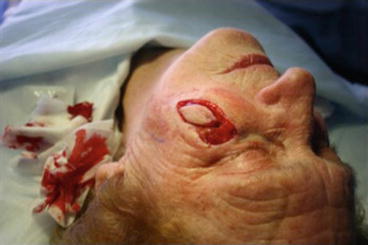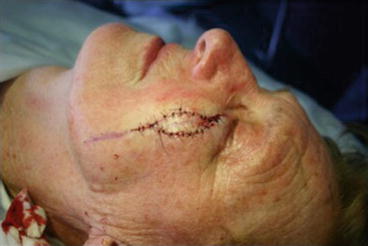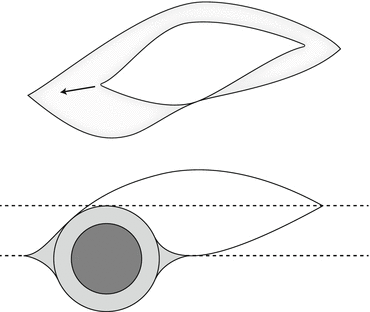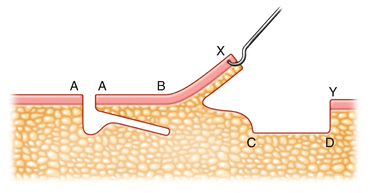Figure 3.1
Sigmoid oblique flap plan

Figure 3.2
Sigmoid oblique flap being raised

Figure 3.3
Sigmoid oblique flap sutured

Figure 3.4
Sigmoid island flap
The Oblique-Sigmoid Island Flap
The oblique-sigmoid island flap was originally described by Ono and colleagues [7]. The design was developed as an attempt to overcome traditional problems with cutaneous island pedicle flaps [8] – trapdoor formation, depressed scar (due to orientation of scar against RSTL or vertical scars on the cheek) and dog-earing.
The Technique
The tumor is excised with adequate margins. Ono originally described a circular excision of the tumor. In my experience, we can simply excise the lesion with adequate margin without paying attention to the exact shape. Ono describes creating triangular skin flaps 1–2 mm in length. This is a particularly important step in my view and it is especially important to orientate the tips of these isosceles triangles in the direction of the RSTL as per the illustration and clinical photographs. A subcutaneous island pedicle flap is created – this has a lazy-S orientation facing the defect and a spindle-shape on the other side (see clinical photographs). The flap then slides in an oblique fashion to close the defect. It is this oblique advancement that reduces the risk of ectropion formation for lower eyelid defects. In my experience, as in Ono’s original review of 32 patients, we don’t usually see trap-door formation or depressed scars, which are relatively common with island pedicle flaps on the cheek – especially if attention is paid to ‘unfolding’ the pedicle while dissection (explained further below). Further, as the post-operative scar is spindle shaped, and orientated along the RSTL, this allows for a much more natural contour defect post-operatively.
It is worth spending some time in discussing the mobilization of subcutaneous island pedicle flaps and the approaches espoused by various authors. Field described a technique wherein longitudinal dissection is done through the pedicle – this effectively creates a bi-pedicled flap is the safest in terms of preventing disruption to the sensation of the flap [9]. Dzubow advocated incising the underlying muscle on all but one side to allow the flap to swing on a muscular pedicle [10]. Heller, on the other hand Heller, describes elevating the flap on a long horizontal pedicle [11].
Chan [12] has described an elegant technique of dissecting island flaps, which in my experience helps to reduce the pin-cushioning that can occur with island flaps. This unfolding of the pedicle also creates less bulkiness post operatively. In Chan’s method, defect XY is created as shown in Fig. 3.5. (my modification of the Chan technique) – A triangular advancement flap AX is marked out. The leading edge of the triangular flap X is undermined just deep to the sub-dermal plexus to about a third of its length B. The tail of the Flap A is then undermined towards the defect, going deeper at a 30° angle as one approaches the defect, to about half of the length of the flap. An oblique subcutaneous pedicle AC is therefore created. The flap is then advanced using AC as a long oblique pedicle, helped by the “unfolding” of the flap BX when the leading edge of the flap was undermined to create the pedicle.


Figure 3.5
Dissection technique of Island flaps cheek
For small defects where there is adequate mobility of the subcutaneous tissue, conventional methods of lateral undermining may be sufficient to advance the flap and no undermining beneath the flap need take place – allowing the flap to ‘sit-on’ the defect. However, when larger defects are concerned (and in this case report I am discussing the use of oblique-sigmoid island flaps to close a large defect >1 cm) conventional techniques of dissecting the V-Y island flap (or indeed any island flap) prove inadequate. This dissection technique often avoids the need for undermining.
Stay updated, free articles. Join our Telegram channel

Full access? Get Clinical Tree








